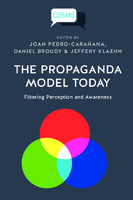The Propaganda Model Today
Filtering Perception and Awareness
| dc.contributor.editor | Pedro-Carañana , Joan | |
| dc.contributor.editor | Broudy , Daniel | |
| dc.contributor.editor | Klaehn, Jeffery | |
| dc.date.accessioned | 2018-10-01 23:55:55 | |
| dc.date.accessioned | 2019-10-24 10:34:35 | |
| dc.date.accessioned | 2020-04-01T11:56:32Z | |
| dc.date.available | 2020-04-01T11:56:32Z | |
| dc.date.issued | 2018 | |
| dc.identifier | 1002463 | |
| dc.identifier | OCN: 1083016051 | en_US |
| dc.identifier.uri | http://library.oapen.org/handle/20.500.12657/27541 | |
| dc.description.abstract | "Thirty years after Chomsky and Herman elaborated the Propaganda Model this title aims to introduce a new generation of readers to it. It presents cutting-edge research demonstrating the model’s general validity as well as new attempts – in the light of digital media and 21st century politics – to critically update, expand, and refine it. International researchers thus analyse the continuities and new developments in media Environments throughout various regions of the world. Part I addresses the theoretical and methodological dimensions of the PM beginning with an interview with Edward Herman on the model itself. Part II reflects on propaganda as a concept and practice within new mediated digital communications systems and interfaces. Applications of the Propaganda Model are featured in Part III notably new forms of media and content not previously analysed within it: the entertainment industries through the analysis of television, professional sports, Hollywood movies and videogames using quantitative and qualitative research methods. The last section presents case studies of corporate media and reporting practices as reflections of elite power. An extensive re-visioning of the PM this book concludes by identifying the fundamental dimensions of the model, the key modifications and expansions that are suggested—such as the inclusion of new filters—whilst assessing the model’s overall value for conducting research in different geographical contexts and media systems and products." | |
| dc.language | English | |
| dc.relation.ispartofseries | Critical Digital and Social Media Studies | |
| dc.subject.classification | thema EDItEUR::J Society and Social Sciences::JB Society and culture: general::JBC Cultural and media studies::JBCC Cultural studies::JBCC1 Popular culture | en_US |
| dc.subject.classification | thema EDItEUR::J Society and Social Sciences::JB Society and culture: general::JBC Cultural and media studies::JBCT Media studies | en_US |
| dc.subject.classification | thema EDItEUR::J Society and Social Sciences::JB Society and culture: general::JBF Social and ethical issues | en_US |
| dc.subject.classification | thema EDItEUR::J Society and Social Sciences::JP Politics and government::JPW Political activism / Political engagement::JPWA Public opinion and polls | en_US |
| dc.subject.classification | thema EDItEUR::J Society and Social Sciences::JP Politics and government::JPV Political control and freedoms | en_US |
| dc.subject.classification | thema EDItEUR::K Economics, Finance, Business and Management::KN Industry and industrial studies::KNT Media, entertainment, information and communication industries::KNTP Publishing industry and journalism::KNTP2 News media and journalism | en_US |
| dc.subject.other | propaganda model | |
| dc.subject.other | media bias | |
| dc.subject.other | Herman and Chomsky | |
| dc.subject.other | filters | |
| dc.subject.other | democracy | |
| dc.subject.other | corporate control | |
| dc.title | The Propaganda Model Today | |
| dc.title.alternative | Filtering Perception and Awareness | |
| dc.type | book | |
| oapen.identifier.doi | 10.16997/book27 | |
| oapen.relation.isPublishedBy | 2725c638-53f3-4872-9824-99c3555366f3 | |
| oapen.relation.isFundedBy | 9e6c8be9-9f16-4ab9-a630-f368a5b55dc1 | |
| oapen.relation.isbn | 9781912656165; 9781912656189; 9781912656196 | |
| oapen.series.number | 8 | |
| oapen.pages | 314 | |
| oapen.place.publication | London | |
| oapen.identifier.ocn | 1083016051 |

